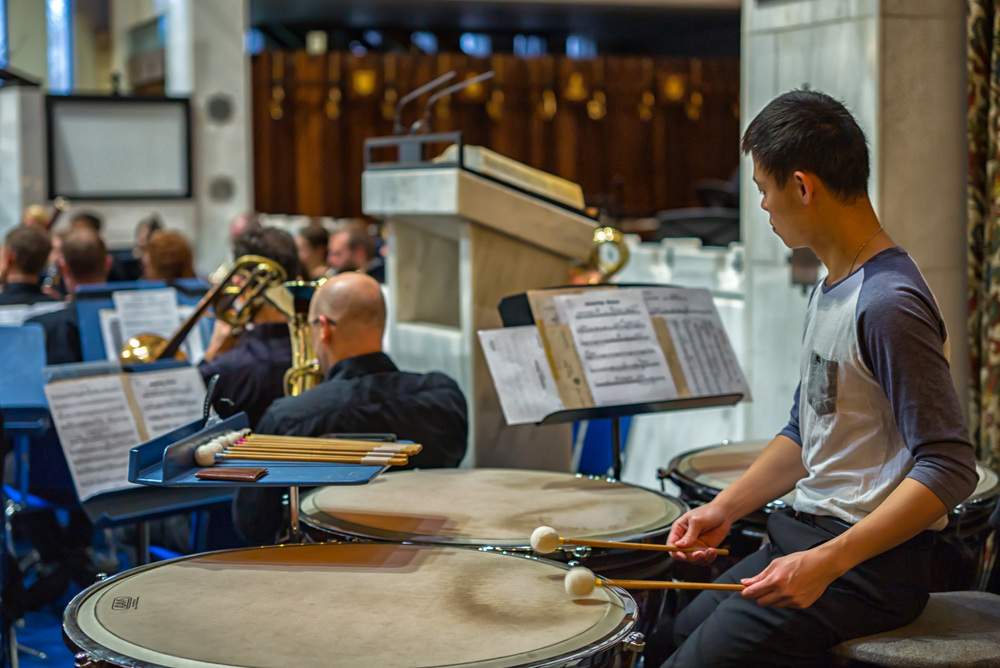
The Leica M Type 262 represents a welcome return to purity in M photography and it deserves to be the most popular model in the range. It has been described as a “stripped-down” M but this is a rather simplistic verdict. In reality, the 262 loses nothing that the typical rangefinder user wants or needs in a camera. So far, it is the nearest we have come to a digital version of a Leica film camera since the M9 and is all the better for it.
Rather than being a stripped-down M240, the M262 is in reality a stepped-up M9. It is an M9, characterised by the stepped top plate, brought up to date and furnished with a CMOS sensor and a usable screen. It is the camera the M240 should have been.
Ask any Leica enthusiasts what they want a digital M to resemble in terms of weight and dimension and they will mention the M3 or, perhaps one of the later film cameras such as the M6 or even M7. These cameras fit in the hand perfectly and have just the right heft to provide a balanced unit when almost any M lens is mounted. The digital Ms, not so much the M8 and M9, but certainly the M240 and its derivatives, are noticeably thicker and heavier than, say, a modern M7.
Lightweight
The M262 goes a long way to satisfying this demand. A full 100g has been shaved off the weight by replacing the brass top plate with with a redesigned aluminium component to marry with the die-cast magnesium body. This new top plate incorporates a distinctive step above the rangefinder window in a nod to the design of the M8 and M9. While fans will welcome the weight saving, which puts the M262 on par with the M7 and only 15g heavier than the M6, they will have to live without the somewhat dubious benefits of the potential brassing effect which can be the sign of a well-used camera (or, more likely, the sign of a strategically rubbed lightly used camera).
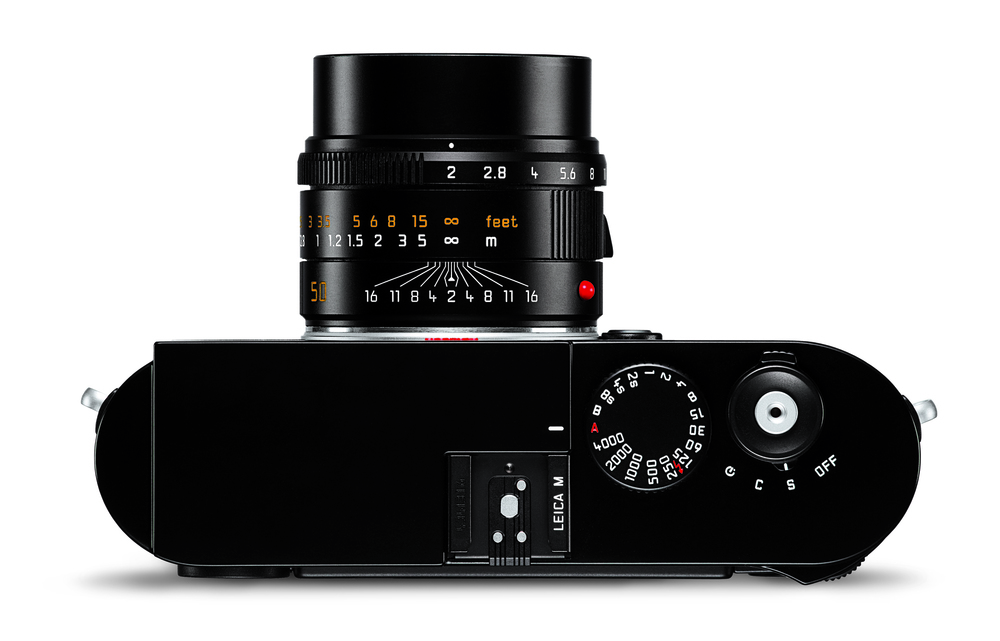
The camera has exactly the same dimensions as the M240 and its derivatives—139x80x42mm—so it still suffers from the extra 7mm of depth that is quite noticeable when swapping rapidly between a film M and the latest digitals. It all adds to the impression that the digital M is larger than it need be.
Despite the identical dimensions, the M262 feels much more like a film camera than the 240. The weight saving is significant and that helps create the illusion that you are holding a smaller device.
Same performance
In terms of performance, the M262 is identical to the M240, with the same 1GB buffer, which rapidly becomes overwhelmed when shooting a succession frames one after the other. It has the same CMOS 24MP sensor, the same Maestro I processor (as opposed to the Maestro II in the Q and SL) and an identical 200-6400 sensitivity range. However, despite using the CMOS sensor (which, unlike the CCD unit in the earlier M8 and M9 models can support the feature) the M262 does not offer live view. This is perhaps one area where buyers might feel short changed but it doesn’t particularly worry me. Nor, I suspect, will it worry potential buyers. The screen is the same 920,000-dot 3in component used in the M240 and is covered with the same Gorilla glass.
Reader Jim Arnold has made the following video of the M262 shutter sound in comparison with his M-E and old M2. It’s not as “barely audible” as we’re led to believe, but it does sound good
For this new camera Leica has developed a metal-blade focal-plane shutter with vertical movement which the factory claims is “barely audible”. It will undoubtedly add to the appeal of the camera, particularly among street photographers who value lack of attention.
One consequence of the absence of live view is the inability to mount the VF-2 electronic viewfinder. Again, this is no great hardship since most M users prefer to rely on the traditional rangefinder. Only with lenses wider than 28mm is an external optical viewfinder necessary. Although I have a VF-2 on the shelf it is seldom to be seen mounted on my digital Ms.

In common with the base M240, the M262 also lacks the traditional frame line adjustment lever on the front of the camera. This lever enables the user to select either of the two alternative pairs of frame lines to visualise the effect of a different focal length. It was a feature of most of Leica’s film cameras and the earlier digitals but, for some reason, Leica dropped it with the introduction of the M240. Whether this was for cost-cutting purposes or simply because they thought it unnecessary I do not know. Significantly, however, it has returned on the higher-spec M-P version of the M240.
Menu simplification
In simplifying the M262 Leica has managed to shrink the main menu to just two pages plus the separate SET menu. Of the 42 menu functions on the M240 only 22 are left on the M262. To achieve this, a number of functions have been deleted (some of them are not relevant in any case because of the absence of live view) and others have been rearranged into sub-menus. For instance, the main menu adjustments JPG rendering are moved to a sub-menu of JPG settings on the M262 (Sharpness, Saturation, Contrast, all with settings sub-menus).
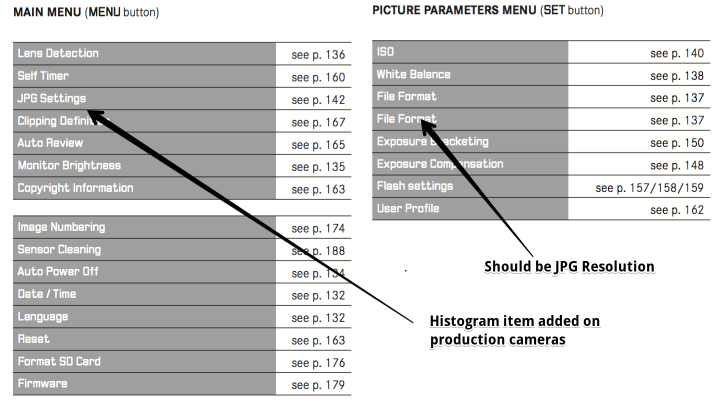
There are a number of significant missing items, including the ability to change the frameline colour (white and red are available on the M240, white only on the M262) and exposure metering. The M262 is fixed at centre-weighted where the M240 also offers spot and multi-field exposure alternatives. The ever-knowledgeable Jimmy Hughes at Leica UK tells me that this omission is not a spoiler, simply that the options other than centre-weighted are a function of live view which, of course, is missing from this camera.
The menu item Histogram, which is missing on the above shots from the manual has been reinstated and on production models on the first page after JPG Settings. Many of the menu items on the M240, such as EVF Brightness, Focus Peaking, Focus Aid, Horizon and Video Mode, are not relevant to the M262.
Below: Several readers asked if the startup time was “as slow as the M240” or faster like the M9. Jim Arnold has produced this video to show that the startup and wake is pretty fast
None of these changes would be a deal-breaker for me and the ultra-simple menu is both welcome and a refreshing alternative to the ever-expanding range of options available on most modern digitals.
Look Ma, no video
Last but certainly not least, the M262 doesn’t do video. I can hear the cheers from Leica fans all over the planet. I have never felt the need to use video with the M and the little button to the right of the shutter release is nothing but a nuisance. At least it can be permanently disabled on the 240. Now, with the M262 it has gone, I hope forever. Good riddance, rest in peace YouTube.
The M262 deserves to be popular. It is the camera the original M240 should have been, before Leica mistakenly decided to join the feature race. Perhaps now the Q and SL are there to satisfy video and electronic-viewfinder addicts, Leica can safely return to basics with the rangefinder models and avoid the mistake of attempting to keep up with the Sony-Jones’s.
Concentration on the basics of rangefinder photography has another potential benefit. Once out of the feature race, the M digitals will have a longer model life. Image quality is already of a very high standard and, without the temptation to keep up with the mirrorless-camera opposition, Leica can concentrate on honing an already successful formula. For owners this will bring a benefit in the form of stronger resale values. Leica now has the opportunity to bring an element of stability to the rangefinder digital and make it even more attractive to those photographers who do not need all the latest bells and whistles.
This camera has all the features you need if your preferred method of working is with a rangefinder. I feel it should be the basis of the new M, which I expect next September: A pure, simple digital experience. If it can be made smaller, returning to the dimensions of the M3, all the better.
The camera used for the purposes of this brief evaluation was loaned by Red Dot Cameras in London. I am waiting for a test model to arrive from Leica..
M240 menus for comparison purposes
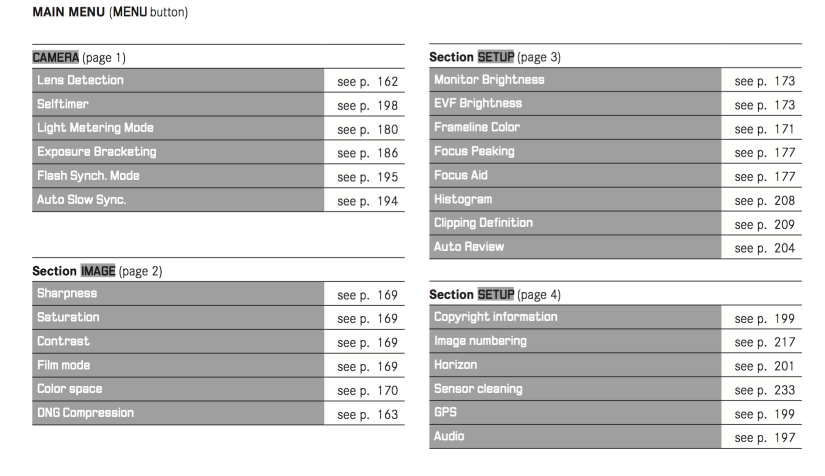
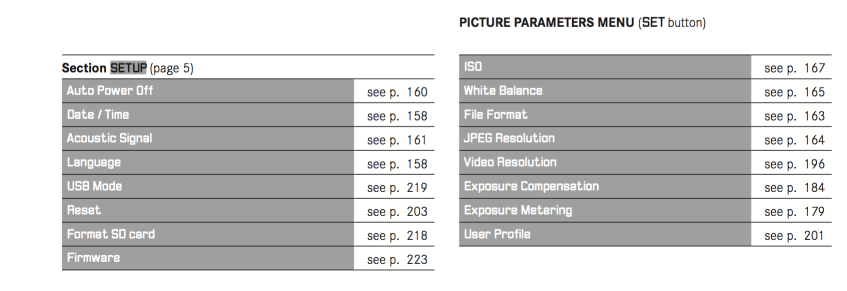

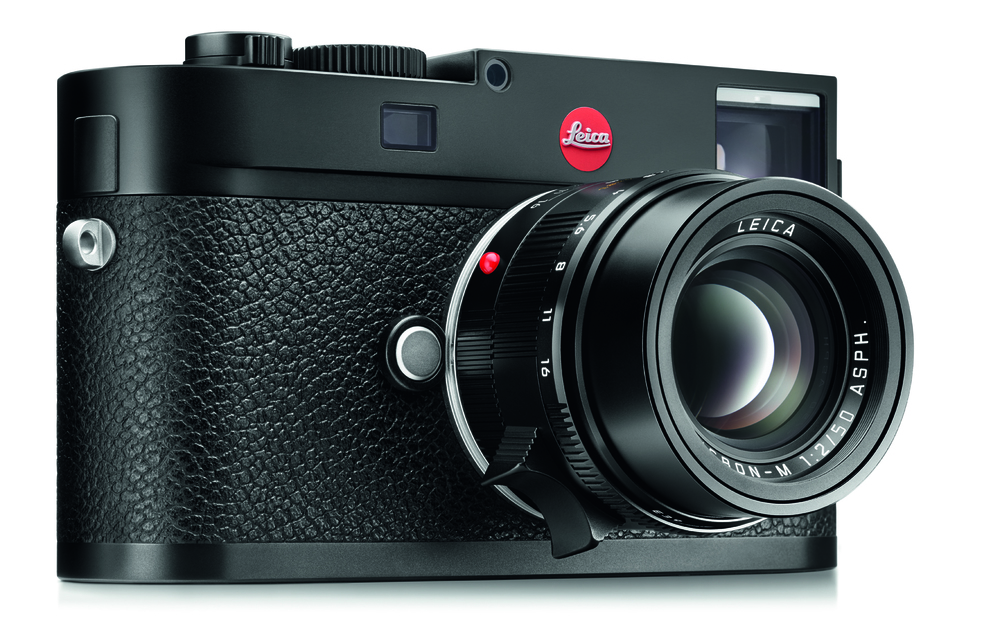
I love mine, my first Leica Digital, the only things I really miss are in body stabilisation and sensor cleaning if the rumoured tie in with Panasonic ever happens we should see there things
Hi Jonathan
Leica has had a cooperation agreement with Panasonic for many years, resulting in, among others, the D-Lux and V-Lux and the Leica DG lenses for the micro four-thirds system cameras. I agree stabilisation and sensor cleaning would be an asset for the M but I suspect both are difficult to implement. The new M is due shortly and we will have to see if there have been any moves towards this.
Tony Edenden.
Well I’ve used Leica’s since ’82. Been using an M9 for 4years. When the M262 was announced I smiled, a feint whiff of common sense at last ! Click.
Absolutely right!
This is a great evolution of the modern M. Now all they need to do for the next M is (a) make the body thinner and (b) remove the LCD altogether. Perhaps also (c) give us built-in 16GB storage a-la Leica T, (d) make it shoot RAW only and (e) enable in-body battery charging — great for travelling. That would be my perfect digital M.
there is a definite place for a camera such as this and I wouldn’t be too surprised if we saw it sooner rather than later. However, removing the screen is probably a step too far for the basic M. I hope the next model will follow the lead of the M262 and, certainly, a bit of thinness would be welcome. I see the screenless "digital M3" has a supplementary model. But, I suspect, Leica would be surprised by the demand. Thanks for your input.
Does the camera turn on as quickly as the M9, or is it slow like the M240?
Jim Arnold, who has both the M262 and his own M-E in front of him says that there is hardly a difference in the startup speed. I don’t currently have access to an M9 but it does seem from what Jim says that the M262 is faster than the M240. He is making a little video to demonstrate this and I will post it in this article when it arrives.
I’ve now added a second video from Jim Arnold to show that the startup time appears to be faster than on the M240. See the main article.
Thanks Mike
A fulsome article. Totally agree about video. It’s not about having a downer on video per se, but just that it has no place on an M camera. Never used it once on my M240, M240P and least likely of all on my MM246.
I had the pleasure of handling a 262 in Red Dot Cameras yesterday. It is a thing of beauty and far better in the hand than the spec suggests. Totally agree about the impression created by the reduction in weight.
Now if only they’d produce a 262 Monochrom!! That surely is an obvious move for them given this initial move back to the M camera’s roots.
Regards
John
Agreed. I missed you by a few minutes at Red Dot yesterday. I had another fondle of the M262 and agree with your impressions. I hope it will represent the starting point for the next M: shave off s few ounces and a little depth and we are back to film-like purity.
Thanks Mike. You are, of course, making my case about avoiding confusing nomenclature. On the other hand it would be more than a a bit optimistic to predict that the Typ 262 will be a matter for discussion and/or collection 65 years from now. The market for collector digital cameras has not really developed yet but, of course, it may eventually do that over time. Recently, a member on the Leica Forum asked whether buying a Leica M60 set would be a good investment over a 12 year period and, in a rare outbreak of unanimity, all of the advice given by fellow members, including myself, was that this was risky from an investment perspective.
On a related matter, I would love to know your views on the future of consumer electronic items, including those made by Apple, as collectibles.
William
You could be right about Leica digital demand in 65 years’ time. I do think that some of the current M digitals could develop collector interest, particularly now we have reached a fairly good level of image quality. Improvements will be made, of course, but a current M (or even an M8/M9) could fill a future niche for a well-designed and solid digital camera. The biggest threat to digitals is undoubtedly component availability, as Leica has already found out with the M8 screen. I hope they are keeping bigger stocks of current components.
In fact, if you look at the history of Leica digitals the record so far has been quite good. The 2004 Digilux 2 is still fetching over half its original cost, despite the small sensor and fairly rudimentary viewfinder. But it does have an excellent lens and can perform well. Similarly, both the M8 and M9 are good cameras. Only today I was chatting to someone who had just bought a used M9-P in preference to an M240-P because he much prefers the rendering of the CCD sensor. I suspect that values of M8s and M9s will hold and could even rise over time.
The difference between consumer electronics, such as Apple, and Leica rangefinders, is that Leicas have an intrinsic value even when the electronics get a bit long in the tooth. They are still essentially craftsman-built devices. Computers, phones and tablets are all electronic, so it isn’t surprising that they don’t become collectors’ items. However, in common with Leica, Macs and iPhones retain useful value long after the opposition has been consigned to the scrap heap.
I am sure that preserved Apple products will have some value in the future (just as we have seen record prices for early Apples and Macs at recent auctions). There will always be a market for well-preserved Macs, particularly if they come with all the original packing.
Anyway, who knows? It’s all conjecture at this stage. I do believe that Leica is in a unique position with the M and the library of M lenses. By retaining the form of the M and avoiding unnecessary dated electronics (vid. the M262) the company can boost used values. This, in turn, will encourage people to buy new versions.
I usually don’t comment on new digital Leicas as often they are just an incremental change or ‘improvement’ on what is there already. In this case there is a certain amount of de-commissioning or ‘back to basics’, as it were. I don’t often use the video feature on my M240 or on any other digital camera that I have. Then sometimes I see something that deserves a video and I have completely forgotten how to use it or to change settings for video! So much for having a ‘Swiss Army knife’ camera.
The real question is whether Leica will go back to basics with the next M. They might also at the same time simplify their range which is looking rather ‘full’ at present. Time will tell, but there seems to be a hard core of traditional Leica users that wants simplicity. This might not, however, appeal to potential new users who might expect more features.
As for the new naming system, it is probably good for Leica fans who want to impress their friends at Leica meets with their mastery of the ‘Toop’ numbering system. The equivalent in the old days was your mastery of the Leica code words such as ‘NOOKY’, SCNOO’ and FOOKH’. So, new oneupmanship possibilities seem to be dawning. Leica needs, however, to avoid confusion like the III Model F being a different camera to the much later IIIf. There are still Leica fans who are confused by such nomenclature 65 years later. So, I hope that Leica will avoid the possibility of anything like that happening
William
I remain confused by the model naming convention of screw-mount Leicas, 65 years on. No doubt in 2080 Leica enthusiasts (if any are left) will be impressing newcomers with their familiarity with Typ 262 et al.
It’s a pity that Leica went over to this silly confusing M24X model namIng .If they had stuck to the simple M8,M9 etc naming it would have been so much easier.
I couldn’t agree more. We are now reduced to using M240/M246 to achieve some form of clarity. And then there is the film MP and the digital M-P which we now have to call the M-hyphen-P to avoid confusion. Even the Monochrom is confusing because we have two different models with the same name. I can’t even remember the Typ (which is pronounced Toop) or Type number for these. Now the little D-Lux has to be called the Toop 109 to differentiate it from the D-Lux 6! Total madness. This was an ill-advised policy change influenced, I suspect, by Apple’s confusing nomenclature (anyone for an 11-in MacBook Air Late 2012 or a 15-in MacBook Pro Mid 2013?).
Why do you have such a down on video? Lots of people love having video on their still cameras, I know I do.
I certainly don’t have a down on video although I don’t do much of it. I just don’t think it has a place on the Leica M which is a very specialised camera appealing to a particular type of person. That person is mostly interested in still photography and prefers the purer approach of rangefinder shooting. Video does have its place and Leica produce other cameras, from the D Lux to the Q and the SL which make a better fist of video. So I welcome a back-to-basics approach which can only enhance the appeal of the rangefinder among those who are fed up with feature bloat and a constant succession of new models with incremental technical improvements from other manufacturers. I think the M rangefinder can continue to sell in its purest form without needing to compete on every single feature of mirrorless cameras from companies such as Sony and Fuji.
I prefer segregation when it comes to video. For a quick video "snapshot" even my 6G iPod Touch is pretty amazing. But if you want the video look afforded by a FF sensor, that is a whole other animal. Once you get past a W/A shot you will want to use tripod and an aid to assist in focusing. Video, when it came to the Canon 5D, caught Canon off guard, but sparked a revolution. DSLRs are a pretty poor platform for serious video shooting, but it can be done. Take a look at what Danfung Dennis did with Canon 5D’s in Afghanistan while under fire (https://www.youtube.com/watch?v=h9SiK6fSNDE). I agree with Mike’s take. He’s spot on.
A useful additional argument which reinforces the good decision to give up on M-video.
Love it, now all we need is for it to have the actual M9 as well and we will all be back to proper Leica colours. Don Morley.
Couldn’t agree with you more. An excellent assessment of Leica’s rangefinder future.